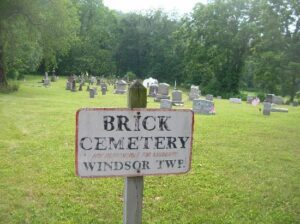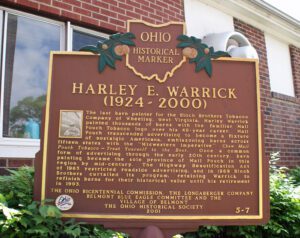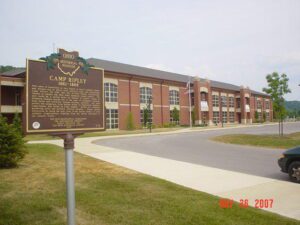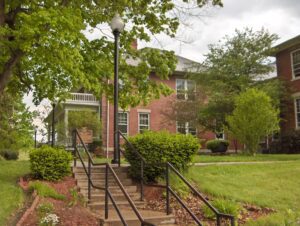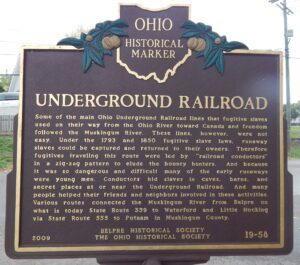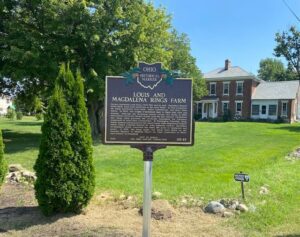, OH
The Windsor Township Baptist Association was organized January 11, 1818 by Elder William Davis with 35 members who met in homes, barns and schoolhouses. At the death of the six-year-old granddaughter of Samuel and Tabitha Davis Henery, this plot by the river was laid out of a church yard and deeded by John Henery in 1837. In 1838 a brick church was built at the cost of $1,000. It served this community until the road and church were destroyed by the flood of 1913. More than 50 men from this area served in the Civil War. Twenty-six War of 1812 veterans are buried here as well as William Davis, veteran of the American Revolution; Obadiah Brokaw, founder of Big Bottom State Memorial; and Captain Isaac Newton Hook, river pilot at the age of ten and U.S. master of inland navigation, 1860-1873, who ran supplies on the Tennessee and Cumberland rivers for the Union Army. At Captain Hook’s death in 1906, the steamers Valley Gem, Zanesville, and Sonoma from Marietta in his honor landed passengers at the church here for his funeral, “largest ever held in the Muskingum Valley.” “The Lord and the River giveth and then taketh away.”
, OH
The last barn painter for the Bloch Brothers Tobacco Company of Wheeling, West Virginia, Harley Warrick painted thousands of barns with the familiar Mail Pouch Tobacco logo over his 48-year career. Mail Pouch transcended advertising to become a fixture of nostalgic Americana, emblazoning barns across fifteen states with the “Midwestern imperative”: Chew Mail Pouch Tobacco-Treat Yourself to the Best. Once a common form of advertising through the early 20th century, barn painting became the sole province of Mail Pouch in this region by mid-century. The Highway Beautification Act of 1965 restricted roadside advertising, and in 1969 Bloch Brothers curtailed its program, retaining Warrick to refinish barns for their historical value until his retirement in 1993.
, OH
With news of hostilities at Fort Sumter in South Carolina, Ripley men formed one of Ohio’s first military units and established Camp Ripley on what was the 12-acre Ripley Fairgrounds. Chosen as Captain was West Point graduate Jacob Ammen. His unit would be a saving force for Ulysses S. Grant’s troops at Pittsburg Landing raising him to the rank of Brigadier General. Soon barns and buildings became military quarters, and tents dotted the landscape from William Street to Maplewood Cemetery. Camp Ripley, also known as Camp Ammen, served as a regional mustering point and military drilling location. Ripley gained distinction as being the only town in the United States to have soldier’s organizations fighting from the Rocky Mountains to the Atlantic Ocean.
, OH
In the first quarter of the nineteenth century, when the general public believed that the insane and paupers could be rehabilitated into productive citizens, the Ohio Legislature gave authorization to county commissioners to establish county “poor houses.” The Athens County Home, formerly known as the Athens County Infirmary, opened on this site in 1857 to provide care for indigent citizens of Athens County. When fire destroyed the original building in 1903, a new building was constructed from 1904-1905, designed with the capacity to house up to one hundred people. When it was built, it was considered to be one of the finest and most modern charitable institutions of its time. The facility continued to provide housing for indigent and elderly residents until 1997 when the County Commissioners closed the home and it became a primary location for the delivery of social services in Athens County. (continued on the other side)
, OH
Some of the main Ohio Underground Railroad lines that fugitive slaves used on their way from the Ohio River toward Canada and freedom followed the Muskingum River. These lines, however, were not easy. Under the 1793 and 1850 fugitive slave laws, runaway slaves could be captured and returned to their owners. Therefore fugitives traveling this route were led by “railroad conductors” in a zig-zag pattern to elude the bounty hunters. And because it was so dangerous and difficult many of the early runaways were young men. Conductors hid slaves in caves, barns, and secret places at or near the Underground Railroad. And many people helped their friends and neighbors involved in these activities. Various routes connected the Muskingum River from Belpre on what is today State Route 339 to Waterford and Little Hocking via State Route 555 to Putnam in Muskingum County.
, OH
German immigrant Louis Rings (1826-1911) and his wife, Magdalena Wolpert (1835-1924), built their farmhouse in the early 1860s. As they prospered, the Rings purchased more land, added outbuildings, and grew their family. In 1904, the couple transferred land to their sons John and William. Although the farmhouse passed outside the family in 1929, descendants lived and farmed nearby until the 21st century. Farmsteads like Rings Farm provided the economic foundation for European immigrants to build Ohio communities. In Washington Township, Rings family members participated in the school board while Magdalena’s Wolpert family helped establish Dublin’s St. John Lutheran Church. Spreading development slowly converted the farm’s 150 acres to businesses and homes. In 1979, the Rings house and barns were listed on the National Register of Historic Places for their connection to Ohio’s agricultural development.


